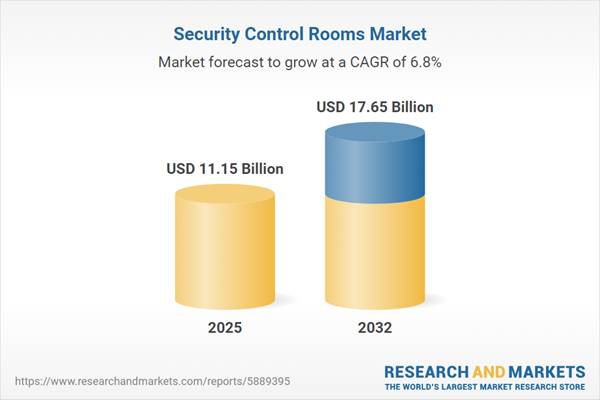Speak directly to the analyst to clarify any post sales queries you may have.
As organizations confront increasingly complex risk environments, advanced security control rooms have emerged as essential infrastructure for business resilience and centralized operational oversight. Executive leaders are shifting focus toward unified, integrated platforms that enable synchronized security operations and streamlined incident response across distributed enterprise assets, addressing today’s evolving threat landscape.
Market Snapshot: Security Control Rooms Market Overview
The global security control rooms market continues to expand, underpinned by rising demand for integrated security architectures to address both physical and cyber vulnerabilities. Digital transformation is accelerating adoption of modern control room solutions that consolidate key data streams for centralized monitoring and workflow automation. Enterprises are leveraging advanced analytics and adaptive system architectures to strengthen situational awareness and facilitate timely incident response. For senior business leaders, secure and unified control room platforms are now recognized as foundational for sustaining operational agility and organizational resilience.
Scope & Segmentation: Security Control Rooms Market
- Control Room Types: Hybrid control rooms support collaboration between onsite and remote staff; conventional physical control rooms serve high-security or large-volume operations; and virtual control rooms enable agile decision-making in flexible, decentralized settings.
- Deployment Models: Cloud-based deployments offer scalability and flexibility for shifting operational needs, while on-premise choices ensure enhanced control and compliance, particularly preferred by heavily regulated sectors.
- Product Categories: Hardware encompasses operator workstations, advanced visual display systems, and secure networking for round-the-clock monitoring. Software delivers analytics and event visualization for rapid threat identification. Services include systems integration, technical support, and tailored workforce training.
- End User Verticals: The market serves banking, insurance, energy, utilities, government, defense, healthcare, telecommunications, manufacturing, education, logistics, and retail, each with unique security priorities and compliance needs.
- Geographic Regions: The Americas, Europe, Middle East and Africa, and Asia-Pacific each demonstrate distinct patterns of technology adoption influenced by local regulations, risk appetite, and infrastructure maturity.
- Industry Players: Notable providers are Honeywell International Inc., Johnson Controls International plc, Schneider Electric SE, Robert Bosch GmbH, Hikvision Digital Technology Co., Ltd., Genetec Inc., Milestone Systems A/S, Cisco Systems, Inc., Motorola Solutions, Inc., and NICE Ltd.
Key Takeaways for Senior Decision Makers
- Advancements in artificial intelligence and machine learning are driving automation in control rooms, resulting in earlier threat detection and a more proactive security stance.
- Cloud-based platforms provide flexible infrastructure that scales with enterprise requirements, making them ideal for organizations managing complex or widely distributed operations.
- Unified platforms centralize management of both physical and cyber security, offering leaders a single point of oversight for enterprise risk.
- Effective governance is key, ensuring all technologies and integrations meet evolving regulatory obligations and align with internal policies to maintain data security and compliance.
- Building strategic partnerships with technology suppliers and adopting managed service models increases organizational adaptability amid regulatory or supply chain shifts.
Tariff Impact: Navigating Cost and Supply Chain Pressures
Recent tariff adjustments in the United States have prompted organizations to reassess their procurement strategies for security monitoring and networking technologies. In response to ongoing global supply uncertainties, many enterprises emphasize domestic manufacturing and localized assembly to mitigate exposure to external risks and meet regulatory benchmarks. By integrating bundled support services into their strategies, organizations can better manage volatility, safeguard operational continuity, and optimize security technology investment.
Methodology & Data Sources
This analysis draws on expert interviews with security operations professionals and market integration specialists. Insights are informed by comprehensive market research, leading industry white papers, and the latest regulatory publications, equipping senior decision-makers with actionable intelligence.
Why This Report Matters
- Supports proactive identification of security gaps, while aligning program priorities with evolving organizational and business goals.
- Aids efficient procurement and benchmarking for investments spanning multiple regions, each with distinct compliance and risk landscapes.
- Presents tactical recommendations that help strengthen enterprise resilience and enable adaptation to fast-changing threat vectors and market forces.
Conclusion
Security control rooms underpin enterprise risk reduction and business continuity plans. This report empowers leaders to confidently select integrated solutions safeguarding critical operations in a dynamic environment.
Additional Product Information:
- Purchase of this report includes 1 year online access with quarterly updates.
- This report can be updated on request. Please contact our Customer Experience team using the Ask a Question widget on our website.
Table of Contents
3. Executive Summary
4. Market Overview
7. Cumulative Impact of Artificial Intelligence 2025
Companies Mentioned
The companies profiled in this Security Control Rooms market report include:- Honeywell International Inc.
- Johnson Controls International plc
- Schneider Electric SE
- Robert Bosch GmbH
- Hikvision Digital Technology Co., Ltd.
- Genetec Inc.
- Milestone Systems A/S
- Cisco Systems, Inc.
- Motorola Solutions, Inc.
- NICE Ltd.
Table Information
| Report Attribute | Details |
|---|---|
| No. of Pages | 188 |
| Published | October 2025 |
| Forecast Period | 2025 - 2032 |
| Estimated Market Value ( USD | $ 11.15 Billion |
| Forecasted Market Value ( USD | $ 17.65 Billion |
| Compound Annual Growth Rate | 6.7% |
| Regions Covered | Global |
| No. of Companies Mentioned | 11 |









